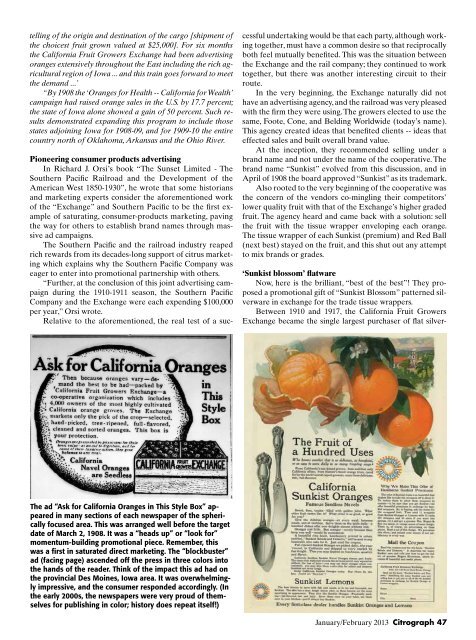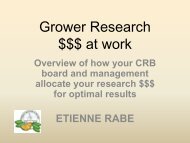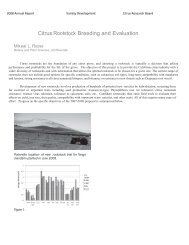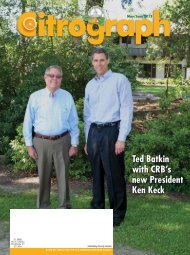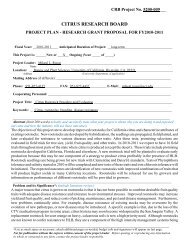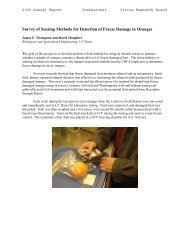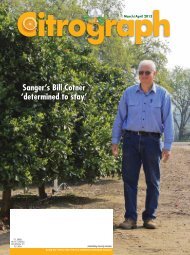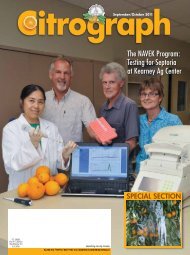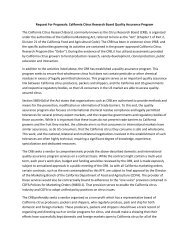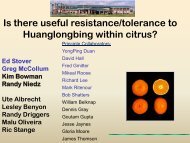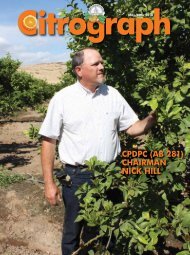Citrograph_JanFeb2013 - Citrus Research Board
Citrograph_JanFeb2013 - Citrus Research Board
Citrograph_JanFeb2013 - Citrus Research Board
Create successful ePaper yourself
Turn your PDF publications into a flip-book with our unique Google optimized e-Paper software.
telling of the origin and destination of the cargo [shipment of<br />
the choicest fruit grown valued at $25,000]. For six months<br />
the California Fruit Growers Exchange had been advertising<br />
oranges extensively throughout the East including the rich agricultural<br />
region of Iowa ... and this train goes forward to meet<br />
the demand ...’<br />
“By 1908 the ‘Oranges for Health -- California for Wealth’<br />
campaign had raised orange sales in the U.S. by 17.7 percent;<br />
the state of Iowa alone showed a gain of 50 percent. Such results<br />
demonstrated expanding this program to include those<br />
states adjoining Iowa for 1908-09, and for 1909-10 the entire<br />
country north of Oklahoma, Arkansas and the Ohio River.<br />
Pioneering consumer products advertising<br />
In Richard J. Orsi’s book “The Sunset Limited - The<br />
Southern Pacific Railroad and the Development of the<br />
American West 1850-1930”, he wrote that some historians<br />
and marketing experts consider the aforementioned work<br />
of the “Exchange” and Southern Pacific to be the first example<br />
of saturating, consumer-products marketing, paving<br />
the way for others to establish brand names through massive<br />
ad campaigns.<br />
The Southern Pacific and the railroad industry reaped<br />
rich rewards from its decades-long support of citrus marketing<br />
which explains why the Southern Pacific Company was<br />
eager to enter into promotional partnership with others.<br />
“Further, at the conclusion of this joint advertising campaign<br />
during the 1910-1911 season, the Southern Pacific<br />
Company and the Exchange were each expending $100,000<br />
per year,” Orsi wrote.<br />
Relative to the aforementioned, the real test of a successful<br />
undertaking would be that each party, although working<br />
together, must have a common desire so that reciprocally<br />
both feel mutually benefited. This was the situation between<br />
the Exchange and the rail company; they continued to work<br />
together, but there was another interesting circuit to their<br />
route.<br />
In the very beginning, the Exchange naturally did not<br />
have an advertising agency, and the railroad was very pleased<br />
with the firm they were using. The growers elected to use the<br />
same, Foote, Cone, and Belding Worldwide (today’s name).<br />
This agency created ideas that benefited clients -- ideas that<br />
effected sales and built overall brand value.<br />
At the inception, they recommended selling under a<br />
brand name and not under the name of the cooperative. The<br />
brand name “Sunkist” evolved from this discussion, and in<br />
April of 1908 the board approved “Sunkist” as its trademark.<br />
Also rooted to the very beginning of the cooperative was<br />
the concern of the vendors co-mingling their competitors’<br />
lower quality fruit with that of the Exchange’s higher graded<br />
fruit. The agency heard and came back with a solution: sell<br />
the fruit with the tissue wrapper enveloping each orange.<br />
The tissue wrapper of each Sunkist (premium) and Red Ball<br />
(next best) stayed on the fruit, and this shut out any attempt<br />
to mix brands or grades.<br />
‘Sunkist blossom’ flatware<br />
Now, here is the brilliant, “best of the best”! They proposed<br />
a promotional gift of “Sunkist Blossom” patterned silverware<br />
in exchange for the trade tissue wrappers.<br />
Between 1910 and 1917, the California Fruit Growers<br />
Exchange became the single largest purchaser of flat silver-<br />
The ad “Ask for California Oranges in This Style Box” appeared<br />
in many sections of each newspaper of the spherically<br />
focused area. This was arranged well before the target<br />
date of March 2, 1908. It was a “heads up” or “look for”<br />
momentum-building promotional piece. Remember, this<br />
was a first in saturated direct marketing. The “blockbuster”<br />
ad (facing page) ascended off the press in three colors into<br />
the hands of the reader. Think of the impact this ad had on<br />
the provincial Des Moines, Iowa area. It was overwhelmingly<br />
impressive, and the consumer responded accordingly. (In<br />
the early 2000s, the newspapers were very proud of themselves<br />
for publishing in color; history does repeat itself!)<br />
January/February 2013 <strong>Citrograph</strong> 47


